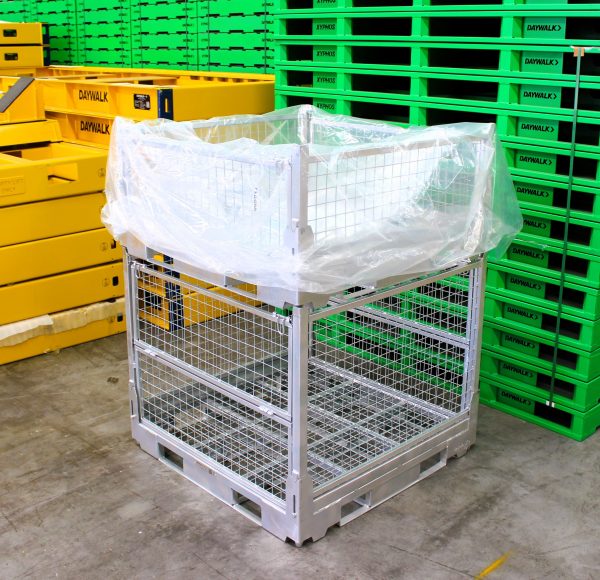So, what’s all this about Australian Standard equipment in my warehouse?
https://youtu.be/_9ZK1DWIOCU
Who sets Australian Standards anyway?
I’ve just got some racking that is rusted at the feet – so what do we do now? who could help fix it for us? or do a racking audit? Can I keep using the beams and buy new legs for the racking?
And once my racking is fixed, what is the correct pallet layout that is Australian Standard approved? When I google Australian Standards for pallets, it appears that the document number is AS 4068-1993: is there an updated version? It seems an old document.
Can someone help me what the standard for pallets is please? Does it matter if I use hardwood pallets, softwood or pine pallets, plastic pallets or steel pallets?
Let’s focus on timber pallets for now. Both hardwood and pine can comply with the Australian Standard AS 4068-1993.
In the section focused on Typical Two-Way Timber Pallets, there are two designs set out, as follows:
- A pallet designed for use in ISO Series 1 freight containers (1100min/1120max x 1100min/1120max)
- A pallet designed for use in Australian Pooling Systems (1160min/1170max x 1160min/1170max)

Style number 2 – typically 1165mm x 1165mm – is the one that most Aussie warehouse operators work with. This is the design that is suited to Australian Standard pallet racking (refer Australian Standard AS 4084-2012).
Who can tell me how many boards my pallets must have top and bottom and also the bearers: what size and length and how many?
BOTTOM BOARDS:
Let’s start with the bottom boards of the pallet, as these actually are in some ways the most important, particularly when you are locking pallets into racking.
So, the Entry Boards – or as they are sometimes called, the Leader Boards – can be up to 150mm wide. These are the front and back boards of the pallet.
Australian Standard pallet racking beams have an outside-to-outside dimension of 840mm. So, a pallet with overall dimensions of 1165mm x 1165mm, that has 150mm wide entry/leader boards means that the dimension inside-to-inside of the entry boards is 865mm.
That means that the pallet fits snugly over the pallets racking beams and is not a sloppy fit.
There are many pallets on the market that only have the two entry/leader boards and one intermediate/stiffener board in the centre.
These still lock well into racking; the Australian Standard (AS 4068-1993) does not state how many intermediate boards there have to be on the base, however the drawing shows the two entry/leader boards and three intermediate/stiffener boards.
There is a specified dimension that has to be complied with in relation to the intermediate/stiffener boards – maximum outer dimension of 430mm. The minimum width of the intermediate boards is 95mm.
The minimum thickness of the bottom boards is 22mm; more typically the standard board thickness would be 25mm.
Style number 2 – typically 1165mm x 1165mm – is the one that most Aussie warehouse operators work with. This is the design that is suited to Australian Standard pallet racking (refer Australian Standard AS 4084-2012).
Who can tell me how many boards my pallets must have top and bottom and also the bearers: what size and length and how many?
BOTTOM BOARDS:
Let’s start with the bottom boards of the pallet, as these actually are in some ways the most important, particularly when you are locking pallets into racking.
So, the Entry Boards – or as they are sometimes called, the Leader Boards – can be up to 150mm wide. These are the front and back boards of the pallet.
Australian Standard pallet racking beams have an outside-to-outside dimension of 840mm. So, a pallet with overall dimensions of 1165mm x 1165mm, that has 150mm wide entry/leader boards means that the dimension inside-to-inside of the entry boards is 865mm.
That means that the pallet fits snugly over the pallets racking beams and is not a sloppy fit.
There are many pallets on the market that only have the two entry/leader boards and one intermediate/stiffener board in the centre.
These still lock well into racking; the Australian Standard (AS 4068-1993) does not state how many intermediate boards there have to be on the base, however the drawing shows the two entry/leader boards and three intermediate/stiffener boards.
There is a specified dimension that has to be complied with in relation to the intermediate/stiffener boards – maximum outer dimension of 430mm. The minimum width of the intermediate boards is 95mm.
The minimum thickness of the bottom boards is 22mm; more typically the standard board thickness would be 25mm.
BEARERS:
Typically in an Australian Standard timber pallet there will be three bearers which run at 90 degrees to the top and bottom boards.
The standard states that the minimum height of bearer is 90mm; the most common is 100mm with a width of 50mm.
TOP BOARDS:
The Australian Standard AS 4068-1993 states that the top entry boards (leader boards) will be a maximum of 150mm in width and a minimum of 22mm thick. The Standard also states that the top intermediate boards will be a minimum of 95mm wide and minimum of 22mm thick.
The number of intermediate boards are not specified in writing; however, the diagrams show that there will be 2 entry/leader boards and 5 intermediate boards
The Standard also states that the pallet will have a maximum overall height of 150mm.
OK, that all sounds informative, but here’s the catch: I have got oversize equipment that sticks out both sides of a standard 1165 x 1165 pallet…what now?
Because a lot of our customers are in the same boat as you, Daywalk has supplied this size pallet before – what is known as a double-width pallet.
See more information on different Daywalk Pallets now.






